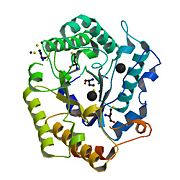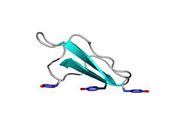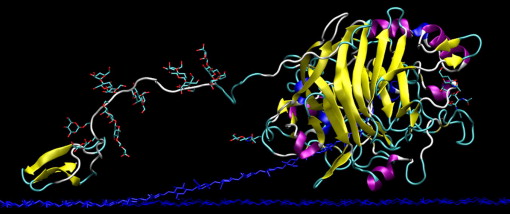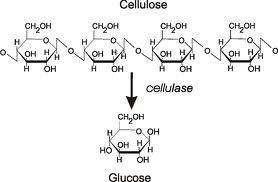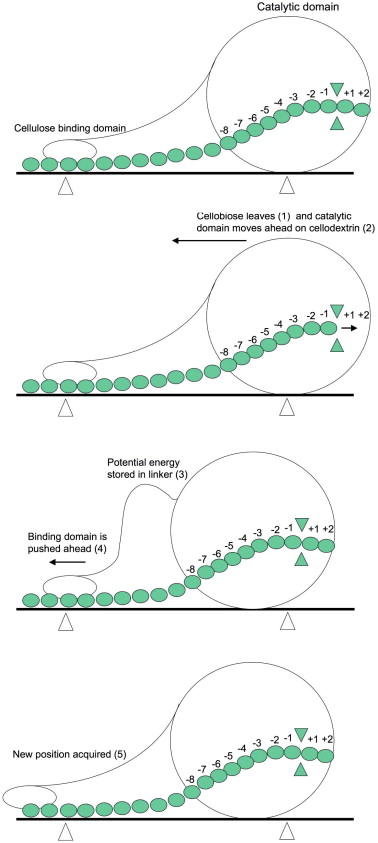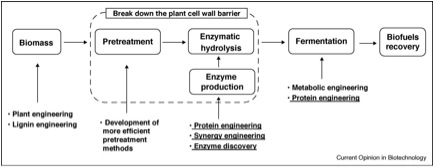Sandbox Reserved 655
From Proteopedia
| This Sandbox is Reserved from 30/08/2012, through 01/02/2013 for use in the course "Proteins and Molecular Mechanisms" taught by Robert B. Rose at the North Carolina State University, Raleigh, NC USA. This reservation includes Sandbox Reserved 636 through Sandbox Reserved 685. | |||||||
To get started:
More help: Help:Editing For more help, look at this link: http://proteopedia.org/w/Help:Getting_Started_in_Proteopedia
Cellulases
Cellulose is one of the main components of the plant cell wall, found predominantly in the xylem tissue which is further protected by hemicellulose and pectin. Cellulases are enzymes that catalyze the hydrolysis of cellulose and belong to a group of enzymes termed glycoside hydrolases (GHs). Several members of the GH family demonstrate a modular architecture composed of one or two catalytic modules connected to several kinds of accessory modules (Schubot et al., 2004). The accessory modules can be involved in numerous functions. For example, some cellulases contain carbohydrate-binding modules (CBMs), which enhance the association of the catalytic modules with insoluble carbohydrates. Cellulases have been characterized as endo or exo according to their mode of action on the substrate (Parsiegla et al., 2002). The endocellulases cleave the cellulose chain at arbitrary points, while exocellulases cleave at the terminus of a chain to start the degradation process. Beta-1,4-glycosidic bonds link together the beta-D-glucopyranose units of cellulose. Beta-1-4-endoglucanase enzymes, produced chiefly by fungi, bacteria and protozoans, specifically cleave the internal bonds of the cellulose chain (Kumar et al., 2008). Particularly interesting among this group of enzymes are the ones produced by thermophilic bacteria e.g. the beta -1,4-glucanase (EC 3.2.1.4)from Alicyclobacillus acidocaldarius (Aa_Cel9A), a thermoacidophilic Gram-positive bacterium, displays a temperature optimum of 343 K and a pH optimum of 5.5 (Eckert et al.,2002). Enzymes that can resist higher temperatures and a range of pHs are required since heat and/or chemical pretreatment processes are currently used to remove lignin to expose cellulose to cellulases (Sticklen, 2008) Structure - the endoglucanase complexIn the past 20 years, researchers have found that endoglucanases cannot break down polysaccharides efficiently without the help of non-catalytic carbohydrate-binding modules. Thus, the 59kDa endoglucanase is mostly found in the form of a complex that is made up of two to three separate domains. The main domain contains the large, globular catalytic domain which expresses the active site. The catalytic module of members of GH family 9 shows an (alpha/alpha)6-barrel structure. The 12 alpha-helices display an alternating connection pattern between outer and inner helices, as is common in (alpha/alpha)6-barrel structures (Parsiegla et al., 1998). The barrel is formed by the parallel inner helices 2, 4, 6, 8, 10 and 12. Besides the 12 alpha-helices, the catalytic module of Aa_Cel9A shows two antiparallel beta-strands and three short alpha-helices which are structurally conserved throughout the family 9 cellulases.A loop of the protein chain forms a tunnel that encloses the . This is attached at the O-glycosylated B block hinge region of the catalytic domain to the smaller, globular CBM at its C-terminal A block by a linker peptide made up of proline, serine, and threonine (Nimlos, et al., 2007).The overall shape of the complex looks like a tadpole, with the A and B blocks forming the extended tail and the catalytic domain forming the head (Pilz, et al., 1990). Some features that may be important for thermostability are the fraction of buried atoms, accessible surface area, and lengths of loops connecting the secondary structures elements ( [Chan et al., 1995] and [Russell et al., 1994]) Methods for Purification: Cation Exchange Chromatography,Gel filtration chromatography Methods for Solving the Structure: X-ray-diffraction, molecular-replacement method using the program PHASER MechanismThe CBM facilitates the enzyme by binding the complex to the cellulose, thus maintaining the proximity of the enzyme and the substrate. It can also target areas of the cellulose that are specific to the enzyme complex. In addition, the CBM itself can disrupt the structure of the cellulose and thus expose the substrate more to the enzyme. The aromatic amino acid residues and planar architecture of the CBM binding sites are complementary to the hydrophobic sites of cellulose chains (hydrophobic 110 face). This exposes the beta-D-glucopyranose rings in the chair conformation, which have their alpha and beta faces having either two or three axial hydrogens exposed and ring hydroxyl groups in the equatorial position, allowing the CBMs to bind efficiently (Nimlos, et al., 2007). The CBM "pulls up" the chain and feeds it into the catalytic domain. The CBM's hydrophoic binding site of three tyrosines remains in contact with the surface throughout the reaction but can freely move translationally. The CBM undergoes a structural conformation after the substrate is in place. The fourth tyrosine (Y13) unfolds from within the CBM and forms a van der Waals interaction with the cellulose surface on the other side of the chain, thus encompassing the reducing end. While the rest of the CBM structure remains fairly rigid because of hydrogen bonds (between strand beta-3 and beta-1 and beta-2) and disulfide bridges (between beta-1 and beta-2) that maintain spacing matching that of the cellulose monomers at the binding site, the fourth tyrosine is located on the remainder of a loop of the protein and is more flexible for the induced fit (Nimlos, et al., 2007). Within the active site, Glutamine (212) acts as a catalytic nucleophile while Trypothan (40) fixes the substrate by hydrophoic interaction at the entrance of the active site tunnel. Similar to myosin and other motor proteins, the enzyme complex is driven by the hydrolysis of the glycosidic bond of cellulose (like phosphate bonds in ATP) as a source of energy for movement along their substrate (Igarashi, et al. 2009).The thermodynamic forces that drive this interaction is controversial, but most researchers postulate that it comes from the positive entropy when the water molecules are released from the protein and ligand (Boraston, et al., 2004). ApplicationsCellulases represent the third largest class of industrial enzymes worldwide because of their use in cotton processing, paper recycling, as detergent enzymes, in juice extraction, and as animal feed additives. The use of cellulases for the production of renewable fuels from lignocellulosic biomass has the potential to create another large industrial consumer of this class of enzymes (Wilson, 2009).
The growing global demand for energy and the environmental problems caused by the burning of fossil fuels have spurred several efforts to develop renewable alternative fuels (Sticklen, 2008). Global climate change will continue to occur due to the increasing effect of carbon emissions in the atmosphere and political clashes will continue to grow over the control and allocation of these depleting resources, and the costs of these fuels will undoubtedly continue to rise (Merino S.T., and Cherry, J., 2007). One potential approach to producing biofuels is to use the carbohydrate polymers located in tailored crops, such as corn stover and switchgrass, as a source of fermentable sugars ( [Sheehan and Himmel, 1999] and [Simmons et al., 2008]). Cellulose is the main polymer of this biomass and the largest organic carbon reservoir on earth (Festucci-Buselli et al., 2007). Physical and/or chemical pretreatment processes that disrupt the hemicellulose–lignin–cellulose complex in plant cell walls are currently used to make the cellulose accessible to cellulases ( [Sheehan and Himmel, 1999] and [Parsiegla et al., 2008]). In order to make cost-effective biofuels, stable cellulolytic enzymes with high activity in post-pretreatment conditions are essential at an industrial scale of production ( [Wilson, 2009] and [Mahadevan et al., 2008]).The bioconversion process uses enzymes such as endoglucanase to break down cellulose into sugars that can be fermented into ethanol (Figure 6) (Wen, et al., 2009. Researchers have been looking to engineer microorganisms to withstand the harsh conditions of the process and to produce the necessary enzymes abundantly. It is necessary to understand these enzymes more fully and to improve them via protein engineering so that biomass can be efficiently and inexpensively converted into biofuels.)
References
(2) Parsiegla, G., Reverbel, C., Tardif, C., Driguez, H., Haser, R. (2008). Structures of mutants of cellulase Cel48F of Clostridium cellulotyticum in complex with long hemithiocellooligosaccharides give rise to a new view of the substrate pathway during processive action. J. Mol. Biol., 375, pp. 499–510 (3) Kumar, R., Sing, S., Singh, O.V. 2008. Bioconversion of lignocellulosic biomass: biochemical and molecular perspectives. J Ind Microbiol Biotechnol. 35: 377-391. (4) Eckert, K., Zielinski, F., Lo Leggio, L. & Schneider, E. (2002). Appl. Microbiol. Biotechnol. 60, 428–436. (5) Sticklen, M. B. (2008). Plant genetic engineering for biofuels production: towards affordable cellulosic ethanol Nature, 9 (2008), pp. 433–443. (6) Nimlos, M.R., Matthews, J.F., Crowley, M.F., Walker, R.C., Chukkapalli, G., Brady, J.W., Adney, W.S., Cleary, J.M., Zhong, L., Himmel, M.E. 2007. Molecular modeling suggests indcued fit of Family 1 carbohydrate-binding modules with a broken-chain cellulose. Protein engineering Design and Selection. 20(4):179-187. (7) Pilz, I., Schwarz, E. Kilburn, D.G., Miller, R.C. Jr., Warren, R.A.J, Gilkes, N.R. 1990. The tertiary structure of a bacterial cellulase determined by angle X-ray-scattering analysis. Biochem. J. 271:277-280. (8) Wen, F., Nair, N.U., Zhao, H. 2009. Protein engineering in designing tailored enzymes and microorganisms for biofuels production. Current Opinion in Biotechnology. 20: 412-419. (9) Zhao, X., Rignall, T.R., McCabe, C., Adney, W.S., Himmel, M.E. 2008. Molecular simulation evidence for processive motion of Tricoderma reesei Cel7A during cellulose depolymerization. Chemical Physics Letters. 460: 284-288. (10) Zhong, L., Matthews, J.F., Hansen, P.I., Crowley, M.F., Cleary, J.M., Walker, R.C., Nimlos, M.R., Brooks III, C.L., Adney, W.S., Himmel, M.E., Brady, J.W. 2009. Computational simulations of the Trichoderma reesei cellobiohydrolase I acting on microcrystalline cellulose 1beta: the enzyme-substrate complex. Carbohydrate Research. 344(15):1984-1992 |
